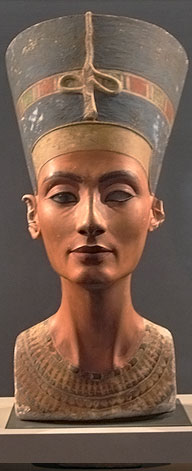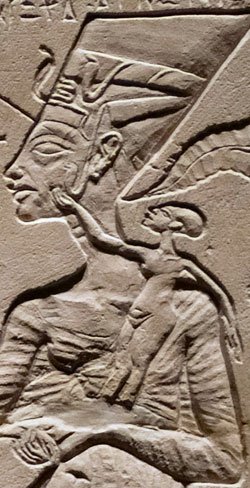QUEEN NEFERTITI OF EGYPT
Nefertiti is known for her elegant beauty. Her bust has been an icon for many women and for many modern cosmetic lines. Many societies around the world have adopted the queen as a symbol of true beauty. Some historians have even proclaimed her the most beautiful woman in the world. Whatever people have said about her, one thing holds true—she remains renowned for her beauty after her death and during her life as a queen.
Nefertiti’s Reign
She ruled alongside Akhenaten during the eighteenth dynasty (1550-1292 BC). Nefertiti means, “The beautiful one has arrived.” She lived in Tell El Amarna, a city constructed by the pharaoh to worship their god Aten. There, they safeguarded their family and their beliefs—it became the center of Egypt’s new religion. It’s believed that Nefertiti was probably a distant relative to Akhenaten and a favorite queen to the pharaoh. Nothing is known about the queen’s childhood and no evidence has yielded who her parents are. Some believe her father could be Aye due to inscriptions found inside his tomb proclaiming him the father of her sister Mutnodjmet.
During her reign as queen, Egypt went about many radical religiouschanges. Hundreds of years of culture and worship had been exchanged for a new radical concept— Monotheism. The old gods had been disregarded, temples shut down, and priests forced to change their ways. Many historians believe this transition could have been hostile and was not adopted so easily by the citizens or priests.
Her reign with Akhenaten was unlike the traditional ways Egypt had seen. She was more than just a typical queen and helped to promote Akhenaten’s views. Her reign was only 12 years, but she was perhaps one of the most powerful queens to ever rule. Supporting her husbands’ beliefs she changed her name to Neferneferuaten-Nefertiti meaning, “The Aten is radiant of radiance [because] the beautiful one has come.” Her importance was greatly valued by Akhenaten and he went to great lengths to show her as his counterpart. As queen, she took on powerful roles and showed herself in ways only Egyptian kings did. For example, she was often shown with the crown of a pharaoh or was depicted in scenes of battle smiting her enemies. Akhenaten valued her so much, that he also allowed her to practice that art of priesthood and she too was allowed to make offerings to Aten.
Many Egyptologists believe that perhaps Akhenaten was born with deformities that hindered his role as king. One of the ailments that was believed he had was bad vision. This illness could have made his job difficult, in turn, he could have put trust into Nefertiti allowing her to decide many important matters. He trusted her so much, that he went as far as placing her name next to his in his royal cartouche. This was very unique and could have symbolized her as equal status next to Akhenaten.
Other depictions show the couple side by side often with their children in a utopic fashion. In one stela, found in Tell el Amarna, the couple is seated together. Akhenaten is giving his daughter an earring while his wife Nefertiti has the other two daughters on her lap. In this depiction, the queen is having a wonderful time and is shown in a loving manner with her husband and children. Both are shown as equal counterparts in their status and family affairs.

Nice Post bro
Ancient Egyptians are fascinating. Their society respect women a lot more than lots of country in the world nowadays.
That's true, the world ought to learn from them